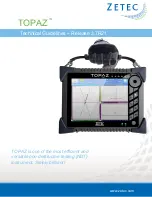
Maintenance and Troubleshooting
6009-33 Broadband At Sea
7-13
7.4.3.
Troubleshooting using DacRemP
While troubleshooting a Sea Tel 3-Axis Antenna System, you must classify the fault you are dealing with as a
failure within one of 3 major system functions, Targeting, Stabilization, and Tracking. Should there be a
failure with any one of these functions, your system will not operate properly. A few simple checks may help
determine which fault (if any) that you are dealing with. The matrix below lists some test(s) and which of the
DacRemP graph selection would be best to use to identify a fault. The end of this chapter contains examples
on how to use DacRemP to diagnose a fault.
Targeting: is the ability to accurately point the antenna to an angular position in free space and is
controlled by the ACU. (Does the system drive to the Azimuth, Elevation, and Polarity positions within 1
degree of the desired satellite?)
Stabilization: is the process of de-coupling the ships motion from the antenna and is controlled by the
PCU. (Does the system maintain the satellite link after turning off TRACKING?)
Tracking: is the process of issuing fine adjustments to the pointing angle of the antenna to optimize the
received signal level and is controlled by the ACU. (Does the system pass a four quadrant-tracking test?)
Functional Test(s)
DacRemP Graph
Selection to use
System Function(s)
Four Quadrant Tracking.
ADMC (Position)
Tracking
Azimuth Encoder Verification.
ADMC (Position)
Targeting
Sea Trial
ADMC (Position)
Targeting
Tracking
Stabilization
Side Lobe Plots
ADMC (Position)
Tracking
Targeting Alignment (AZ & EL Trims)
ADMC (Position)
Targeting
Determine Blockage Mapping
ADMC (Position)
Tracking
Unwrap recovery (Limited Az systems only)
ADMC (Position)
Stabilization
Pedestal Gain Verification
DISPIVC (Loop Error)
Stabilization
Home switch (flag) verification (Unlimited Az
systems only)
DISPV (Ref)
Stabilization
Remote Tilt Verification
DISPV (Ref)
Targeting
Stabilization
Level cage alignment Verification (sensor
alignment)
DISPV (Ref)
Targeting
Stabilization
Rate Sensor Output Verification
DISPW (Rate)
Stabilization
Level and CL fine balance Verification
DISPTC (Drive)
Stabilization
AZ Friction Torque Test
DISPTC (Drive)
Stabilization
DishScan Drive/Phase
DishScan XY
Tracking
Stabilization
7.4.4.
Antenna Loop Error Monitoring
The DacRemP DISPIVC graph chart provides a means for monitoring the accumulated velocity errors of the
antenna for diagnostic purposes. If this error is excessive, it indicates external forces are acting on the
antenna. These forces may be the result of but not restricted to static imbalance, excessive bearing friction,
PRELIMINARY
Summary of Contents for 6009-33
Page 3: ...PRELIMINARY ...
Page 4: ...PRELIMINARY ...
Page 8: ...6009 33 Broadband At Sea Introduction viii This Page Intentionally Left Blank PRELIMINARY ...
Page 18: ...6009 33 Broadband At Sea Installation 3 6 This Page Intentionally Left Blank PRELIMINARY ...
Page 66: ...6009 33 Broadband At Sea DRAWINGS 9 2 This Page Intentionally Left Blank PRELIMINARY ...
Page 68: ...PRELIMINARY ...
Page 72: ...PRELIMINARY ...
Page 73: ...PRELIMINARY ...
Page 75: ...PRELIMINARY ...
Page 77: ...PRELIMINARY ...
Page 79: ...PRELIMINARY ...
Page 81: ...PRELIMINARY ...
Page 83: ...PRELIMINARY ...
Page 85: ...PRELIMINARY ...
Page 87: ...PRELIMINARY ...
Page 88: ...PRELIMINARY ...
Page 89: ...PRELIMINARY ...
Page 91: ...PRELIMINARY ...
Page 93: ...PRELIMINARY ...
Page 95: ...PRELIMINARY ...
















































